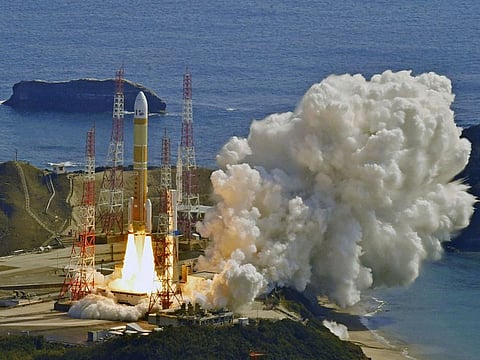Video: Japan's new H3 rocket fails to reach orbit, destruct command issued
Rocket ordered to self-destruct minutes after liftoff

Tokyo: The inaugural launch of a next-generation Japanese rocket is being aborted with a self-destruct signal because the second-stage engine failed to ignite, the Japan Aerospace Exploration Agency said, dashing the country's apirations to challenge Elon Musk's SpaceX.
JAXA decided to scrap the mission after lift-off, it said in a statement Tuesday. It wasn't clear whether the self destruct reached the rocket yet or not. The failure is a blow for Japan's space agency JAXA, after the rocket failed to even lift off on its first try last month.
Tuesday's launch from the Tanegashima Space Center in southwestern Japan initially appeared to be a success, with the flagship rocket lifting off at 10:37am (0137GMT).
The first stage separation appeared to go as planned, but soon afterwards, signs of trouble emerged.
"It seems that the velocity is coming down," announcers on the JAXA live feed said, with the command centre then announcing: "The second stage engine ignition has not been confirmed yet, we continue to confirm the situation."
H3 rocket
The 63-meter-tall rocket, developed and created by Mitsubishi Heavy Industries Ltd., was the country's latest attempt to capitalise on growing demand in the global space industry. JAXA's H3 has large parts that can be recycled but the rocket itself cannot be landed and launched again while touting its competitive prices and reliability. The H3's primary mission was to deliver into orbit a satellite known as DAICHI-3, which is equipped with various instruments including a sensor designed to detect missile launches that's being tested in space for the first time by the Japanese defense ministry.
The live feed was then briefly halted, with a message reading "We are currently checking the status. Please wait."
When it resumed, the command centre announced the news.
"Destruct command has been transmitted to H3 because there was no possibility of achieving the mission."
There was no immediate explanation for why the launch failed.
Mitsubishi Heavy shares fell as much as 3.2% after the launch failure.
The H3 is a launch vehicle for an observation satellite, and the rocket has been mooted as a possible competitor to SpaceX's Falcon 9.
Sign up for the Daily Briefing
Get the latest news and updates straight to your inbox



